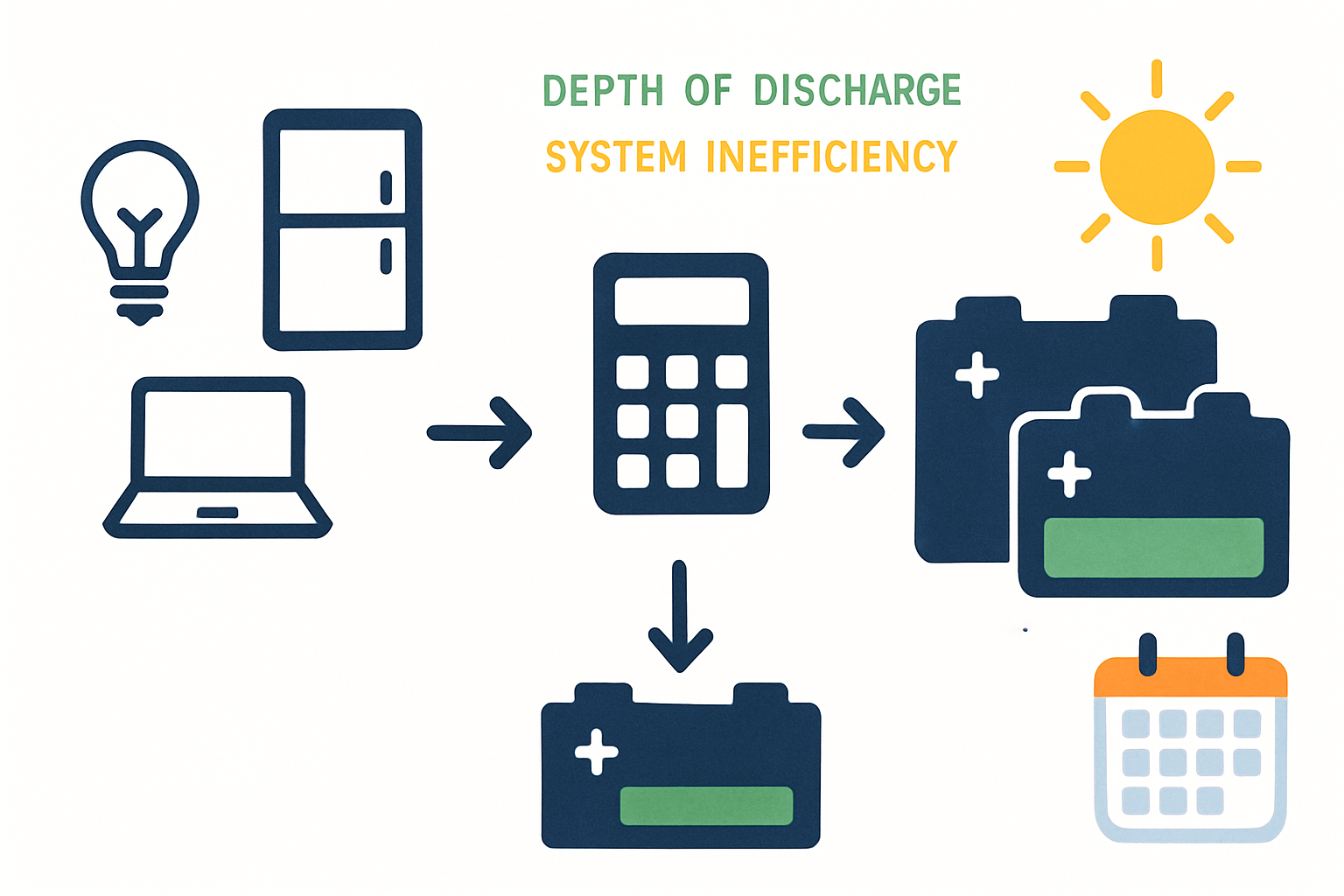Creating a reliable home battery storage system begins with one critical step: correct sizing. An undersized system leads to frequent power shortages, while an oversized one results in wasted investment. This guide provides a clear, step-by-step blueprint for calculating your residential battery capacity, ensuring your energy storage solution is both efficient and cost-effective.
Step 1: Conducting a Thorough Home Energy Audit
Before you can size your battery bank, you must understand your electricity consumption. An energy audit is a detailed assessment of your power usage. It's the foundation of an accurate off-grid battery bank sizing calculation.
Identifying Your Daily Power Consumption
The first task is to calculate your total daily energy use in watt-hours (Wh). You can do this by listing every electrical appliance in your home, noting its power rating in watts (W), and estimating how many hours you use it each day. Multiply the watts by the hours to get the daily watt-hours for each device, then sum them all up.
For a broader view, your monthly utility bills can provide an average daily consumption. According to the U.S. Energy Information Administration (EIA), the average U.S. household uses about 10,500 kilowatt-hours (kWh) per year, which averages to roughly 28.7 kWh (or 28,700 Wh) per day. However, your actual usage may vary significantly based on your location and lifestyle.
| Appliance | Power Rating (Watts) | Daily Usage (Hours) | Daily Energy (Watt-hours) |
|---|---|---|---|
| Refrigerator | 150 W | 8 hours (cycling) | 1200 Wh |
| LED Lights (10) | 100 W (total) | 6 hours | 600 Wh |
| Laptop | 65 W | 5 hours | 325 Wh |
| Television | 120 W | 4 hours | 480 Wh |
| Microwave | 1000 W | 0.5 hours | 500 Wh |
| Total Estimated Daily Consumption | 3105 Wh |
Differentiating Between Critical and Non-Essential Loads
Not all appliances are essential during a power outage. Separating your loads into 'critical' and 'non-essential' categories can significantly impact your required battery size. Critical loads include items like refrigerators, medical equipment, lights, and well pumps. Non-essential loads might include entertainment systems, dishwashers, or air conditioning. Sizing your system to power only critical loads is a practical way to reduce initial costs while ensuring reliability for what matters most.
Step 2: Key Technical Factors in Battery Sizing
Once you know your energy needs, several technical factors will influence the final size of your home battery storage system. Understanding these concepts is crucial for building a resilient and long-lasting solution.
Understanding Depth of Discharge (DoD)
Depth of Discharge (DoD) refers to the percentage of a battery's capacity that has been used. For example, a battery discharged to 30% of its capacity has a 70% DoD. Lithium Iron Phosphate (LiFePO4) batteries have a major advantage here, as they can be safely discharged to 80-100% DoD without significant degradation. In contrast, traditional lead-acid batteries are often limited to a 50% DoD to preserve their lifespan. This means a LiFePO4 battery provides more usable energy for the same rated capacity.
Planning for Days of Autonomy
Days of autonomy refers to the number of consecutive days your battery system can power your loads without any energy input from solar panels or the grid. This is a critical buffer against cloudy weather or extended outages. For most residential off-grid systems, planning for one to three days of autonomy is a common recommendation. Systems requiring higher reliability or located in areas with unpredictable weather may need to plan for more.
Accounting for System Inefficiencies
No energy transfer is 100% efficient. Energy is lost as heat during the process of charging and discharging the battery, as well as when converting DC power from the battery to AC power for your home. This is measured by round-trip efficiency. Modern LiFePO4 battery systems can achieve a high round-trip efficiency, often between 90% and 95%. Older technologies or poorly configured systems might have efficiencies closer to 80%. You must account for these losses by slightly oversizing your battery bank.
Step 3: Putting It All Together: The Sizing Calculation
With your energy audit and technical factors in hand, you can now calculate the required capacity of your battery bank. This calculation ensures your system meets your specific needs for autonomy and reliability.
The Core Formula for Battery Capacity
The fundamental formula for determining your required battery capacity in watt-hours is:
Battery Capacity (Wh) = (Daily Energy Consumption (Wh) × Days of Autonomy) / (Depth of Discharge × System Efficiency)
Let's use an example: Suppose your daily consumption is 5,000 Wh, you want 2 days of autonomy, and you are using a LiFePO4 battery system.
- Daily Energy: 5,000 Wh
- Days of Autonomy: 2
- Depth of Discharge: 90% (0.90)
- System Efficiency: 92% (0.92)
Calculation: (5,000 Wh × 2) / (0.90 × 0.92) = 10,000 / 0.828 ≈ 12,077 Wh or 12.1 kWh.
Converting Watt-Hours to Amp-Hours
Battery capacity is also often expressed in amp-hours (Ah). To convert watt-hours to amp-hours, you divide by the system's voltage (V). Common system voltages are 12V, 24V, and 48V.
Battery Capacity (Ah) = Total Watt-Hours (Wh) / System Voltage (V)
Continuing the example with a 48V system:
12,077 Wh / 48V ≈ 252 Ah. In this case, a 48V, 250-300Ah battery bank would be a suitable choice.
Beyond the Numbers: Practical Considerations
A successful residential battery capacity calculation goes beyond formulas. Practical factors ensure your system is safe, durable, and ready for the future.
Scalability and Future-Proofing Your System
Your energy needs may grow over time. Consider choosing a modular battery system and a capable inverter that allows you to add more storage capacity later. This scalability provides flexibility as your household's demands change.
The Role of a Battery Management System (BMS)
A Battery Management System is the brain of a lithium battery pack. It protects the cells from overcharging, over-discharging, extreme temperatures, and short circuits. An effective BMS is non-negotiable for ensuring the safety and maximizing the long lifespan of a LiFePO4 battery bank.
Performance Metrics That Matter
While capacity is a primary focus, overall system performance depends on more than just watt-hours. A detailed analysis of solar storage performance highlights that round-trip efficiency and cycle life are critical for long-term value. According to the Ultimate Reference for Solar Storage Performance, a system with higher efficiency delivers more usable energy from every charge, maximizing your investment in solar generation.
Finalizing Your Energy Storage Blueprint
Accurately sizing your home battery storage system is a foundational step toward achieving energy independence. By carefully auditing your energy consumption, understanding key technical factors like DoD and autonomy, and applying the correct formulas, you can design a system that is perfectly tailored to your needs. This thoughtful approach ensures your energy storage solution will be reliable, efficient, and valuable for years to come.
Frequently Asked Questions
How does temperature affect my battery bank size?
Extreme cold or heat can reduce a battery's effective capacity and lifespan. LiFePO4 batteries have a wider operating temperature range than other types, but performance can still be affected. If your batteries will be in an unconditioned space, you may need to oversize them slightly to compensate for performance degradation in extreme temperatures.
Should I size my system for 100% of my energy needs?
Not necessarily. Sizing for 100% of your peak usage can be expensive. A more common approach is to size for your average daily use and focus on covering critical loads. This provides a balance between cost and functionality, especially for grid-tied systems where you can still draw from the grid if needed.
Can I add more batteries to my system later?
Yes, if your system is designed for it. Using a scalable inverter and a modular battery system allows for future expansion. It is important to use batteries of the same model, age, and chemistry when expanding to ensure balanced performance and prevent damage to the system.





Leave a comment
All comments are moderated before being published.
This site is protected by hCaptcha and the hCaptcha Privacy Policy and Terms of Service apply.